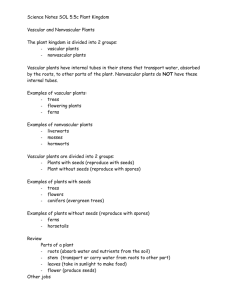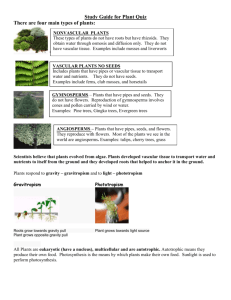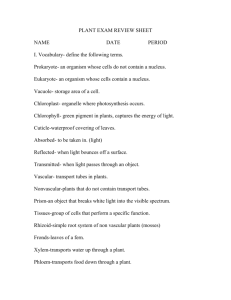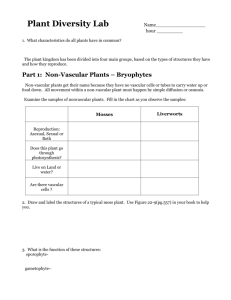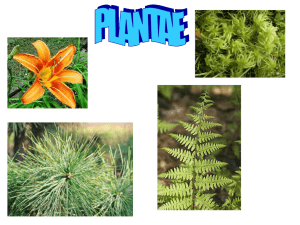Chapter 22 The Plant Kingdom
advertisement
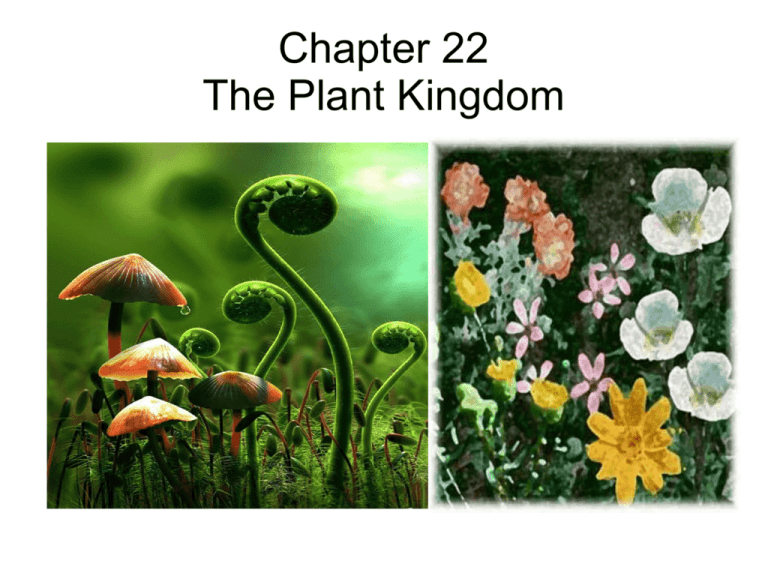
Chapter 22 The Plant Kingdom Plants What are plants? Eukaryotic, multicellular organisms that have chlorophyll and carry out photosynthesis For the most part, they are terrestrial Live in almost all types of environment Can be big, or can be small Remember, they are autotrophic! Plants are Invading the Land! About 500 million years ago, a group of green algae developed adaptations that enabled them to invade the land. • Over 85% of land plants are flowering plants, the Angiosperms. • 14% are mosses and ferns. • 1% are conebearing plants (Gymnosperms). • The challenges to invading the land include: • preventing water loss • absorbing and transporting water • fertilization and protection of the embryo • Structural support Alternation of Generations Plants have a life cycle that involves two distinctly different generations Sporophyte generation is diplod (2N) and has plant parts in which meiosis can take place to be haploid Gametophyte generation is haploid (N) and develops structures that produce gametes The gametes will be produced through mitosis When two haploid gametes unite a diploid zygote is formed Nonvascular Plants Nonvascular plants include mosses, hornworts, and liverworts, and are commonly known as bryophytes They all have these following characteristics They lack vascular tissue They do not have true roots or leaves The gametophyte generation is the most prominent part of the life cycle Sperm swim to the egg Moss Life Cycle The moss plant you generally see is the gametophyte generation Two structures that produce gametes Antheridium is made up of a jacket of cells surrounding the developing sperm Archegonium is a flask shaped structure that produces the egg When sperm mature, antheridian opens and sperm will swim through a film of dew or rainwater to archegonium Sperm and egg nuclei fuse, diploid zygote is produced and is in the sporophyte generation Vascular Tissue Plants, excluding the bryophytes have a vascular system to transport water and nutrients throughout the plant Roots are underground structures that anchor the plant and absorb water and minerals Leaves are structures specialized for carrying out photosynthesis Stems are structures which connect the roots with the leaves and position the leaves so they receive sunlight Vascular Tissue Two kinds of vascular tissue: xylem and phloem Xylem consists of a series of dead, hollow cells arranged end to end to to form a tube Carries water and minerals up from the roots through the stem to the leaves Phloem carries organic molecules (sugars, aa) produced in the leaves to other parts of the plant where growth takes place Roots Roots never stop growing by their tips to try and get new territory for available nutrients and water Most roots are storage places for the food produced by the plant to store during harsher seasons Some roots are a source of food for us, such as carrot, turnips, and radishes Stems Two basic functions of stems: Support the leaves Transport raw materials from root to leaves and food from leaves to roots Inside the bark here are seven layers of xylem tissue. Each layer of xylem constitutes 1 years tree growth Leaves Leaves carry out photosynthesis Have a large surface area to try to collect as much sunlight as possible Stomates open and close to control the rate at which water is lost and gases are exchanged During times of drought, the stomates are closed to reduce the rate at which the plant loses water Seedless Vascular Plants Seedless vascular plants include whisk ferns, horsetails, club mosses and ferns They have vascular tissue, but do not produce seeds Not as limited to wet areas as nonvascular plants, because they have roots and vascular tissue. Still need water to move sperm Ferns Most abundant of the seedless vascular plants Found in greater number in the tropics, but can be found throughout the world Some are very small, while some can grow to be very large. Some have trunks which are 79 feet high, and leaves that grow up to 16 feet long The stage you see when looking at ferns are mostly sporophytes The vertical leaves on ferns are known as fronds On the underside of the fronds, the spore producing parts are located, known as sori (sorus) Fern Life Cycle Seed-Producing Vascular Plants • Seed is a specialized structure that contain an embryo, along with stored foot, enclosed in a protective coat, known as a seed coat • Two major groups of plants that produce seeds: • Gymnosperms (conifers) • Angiosperms (flowering plants) Gymnosperms • Gymnosperms (naked seed plants) are plants that have cones (woody structures) where their seeds are produced. • Pollen grains are the male gametophytes, and the transfer of pollen is known as pollination. Gymnosperm Life Cycle Types of Gymnosperms • Cyads – are stout, woody gymnosperms that have a ring of fernlike leaves on the top that live in tropical regions. • Ginkgo trees- have fan-shaped leaves. There is only one species left, Ginkgo biloba. Reproductive strucutres of ginkgos are on separate trees. Types of Gymnosperms • Conifers are the common trees and shrubs that bear seeds in cones and many have needleshaped leaves. Angiosperms • Angiosperms are plants that produce flowers and have their seeds enclosed in fruit. • Fruit is a modification of the ovary wall into a special structure that contains the seeds. • Flower is the structure, composed of highly modified leaves, that is responsible for sexual reproduction. Flower Structure • Pistil is at the center of a flower, which is composed of the stigma, style and ovary. • Stigma is the terminal portion of the pistil and is meant to receive pollen. • Style is where the male gamete travels down into the ovary • Ovary is the female reproductive structure • Stamen is male organ of a flower • Filament is the stalk of the anther • Anther contains pollen sacs. The sacs release pollen on to the outside of the anthers that brush against insects on entering the flowers. Flower Structure



